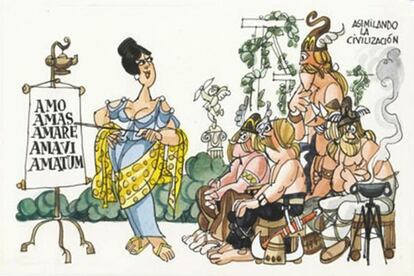Panel show: Antonio Mingote’s cartoon history lessons
The Museo Abc looks back at the work of the artist, who died in April

Before he died, Antonio Mingote, the great Abc newspaper cartoonist, knew they were preparing a tribute to him. He knew that most of the original drawings of his Historia de la gente (or, History of the people) series were to go on show for the first time at the Abc Museum of Drawing and Illustration in Madrid. That exhibition is now finally with us, though Mingote, alas, is not. The artist died on April 3 aged 93.
Three hundred and 16 illustrations are spread out chronologically through the exhibition space, offering a journey through human evolution, from prehistoric times to the 20th century, via ancient Egypt, Rome, the Baroque period and Romanticism. And there they will stay until September 2 under the title (Breve) Historia de la gente (or, (Brief) History of the people).
The drawings on show don’t represent the complete series. “More than 200 illustrations remained in [Mingote’s] drawers,” explains the coordinator of the exhibition, Inmaculada Corcho, who is also the director of the Abc Museum.
“All are good, but we wanted the show to have the more general character of a universal history and the ones that were put away had more specific themes.”
Born in Sitges in 1919, Mingote had his first cartoon published at the age of 13 in 1932, and after moving to Madrid eventually started working for Abc in 1953. He was a friend of the great screenwriter Rafael Azcona, who also introduced him to the pages of La Codorniz, the big humor publication of the day.
Mingote said he took the history of ancient peoples as a pretext to talk about the people of today. “Everybody has a theme and mine is that: people’s eccentric behavior, their capacity for great heroics and enormous stupidities, the small decisions and immense errors,” he once said.
Passing through the rooms commenting on the illustrations, Isabel Vigiola, Mingote’s wife of 46 years, stops in front of one she says was one of his favorites: a Spanish-American family tree that starts at the top with a Spaniard, a black woman and an Amerindian woman and parodies the mixing of races with a colonialist touch. “I am impartial but... they are pretty, right?” says Vigiola. “It is a fun way of learning about history.”
Mingote’s cartoons have their basis in the history books. “Antonio read continuously, he did a lot of research. Everything he knew he had studied since childhood, without Google. And they never found a mistake,” says Vigiola.
In the Historia de la gente series, which he began in 1980 and finished in 1983, Mingote put humankind’s actions in quotation marks. One clear example is the illustration comparing prehistoric fights between cavemen with modern-day boxing, “a civilized sport.” They are two images with the same characters but a different setting.
From time to time, Vigiola sighs. It was only two months ago that her husband was still alive and the work of compiling the legacy that he left has piled up. “I have found drawings I didn’t know existed. There are individual texts that deserve to be illustrated but I wouldn’t know who to entrust with them.” She reveals she sometimes admired him more as a writer — Mingote published several novels — than as an illustrator.
One of the unpublished works that he wrote and illustrated was Historia de los Pérez. The text reaches back to 1936 and also goes over the evolution of humankind but via some made-up characters: the Pérez. It is unfinished but Vigiola says she plans to publish it. “He said it was his masterpiece.”
(Breve) Historia de la gente. Until September 2 at Museo ABC de Dibujo e Ilustració, C/ Amaniel 29-31, Madrid. www.museoabc.es
Tu suscripción se está usando en otro dispositivo
¿Quieres añadir otro usuario a tu suscripción?
Si continúas leyendo en este dispositivo, no se podrá leer en el otro.
FlechaTu suscripción se está usando en otro dispositivo y solo puedes acceder a EL PAÍS desde un dispositivo a la vez.
Si quieres compartir tu cuenta, cambia tu suscripción a la modalidad Premium, así podrás añadir otro usuario. Cada uno accederá con su propia cuenta de email, lo que os permitirá personalizar vuestra experiencia en EL PAÍS.
¿Tienes una suscripción de empresa? Accede aquí para contratar más cuentas.
En el caso de no saber quién está usando tu cuenta, te recomendamos cambiar tu contraseña aquí.
Si decides continuar compartiendo tu cuenta, este mensaje se mostrará en tu dispositivo y en el de la otra persona que está usando tu cuenta de forma indefinida, afectando a tu experiencia de lectura. Puedes consultar aquí los términos y condiciones de la suscripción digital.
Últimas noticias
Maduro pleads not guilty before the federal court in New York: ‘I am still the president of Venezuela’
A new test can detect Alzheimer’s from a finger prick
UN team enters Sudanese city of El Fasher after paramilitary massacre: ‘It’s like a ghost town’
A recipe for resistance: Indigenous peoples politicize their struggles from the kitchen
Most viewed
- Gilles Lipovetsky: ‘If you want to live better and fall in love, take Prozac, don’t look to philosophy’
- Alain Aspect, Nobel laureate in physics: ‘Einstein was so smart that he would have had to recognize quantum entanglement’
- Maduro’s downfall puts China’s relationship with Venezuela to the test
- Why oil has been at the center of Venezuela-US conflicts for decades
- Alvin Hellerstein, a 92-year-old judge appointed by Bill Clinton, to preside over Maduro’s trial in New York








































